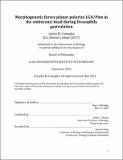Morphogenetic forces planar polarize LGN/Pins in the embryonic head during Drosophila gastrulation
Author(s)
Camuglia, Jaclyn M.
DownloadThesis PDF (2.228Mb)
Advisor
Martin, Adam C.
Terms of use
Metadata
Show full item recordAbstract
During embryonic development, epithelial tissues grow and undergo dramatic changes to adopt complex shapes. Coordinated cell behaviors, including oriented cell divisions are crucial to the proper development of epithelia. How forces are transmitted across the developing embryo and how these forces along with genetic programs that are active at this time contribute to coordinated cell behaviors remains a long-standing question in biology. This work addresses how forces transmitted through the early Drosophila embryo result in the planar cell polarity of Pins/LGN localization and cell division orientation. I demonstrate that this striking planar cell polarity and division orientation depend on forces that result from morphogenetic movements on the other side of the embryo (~100μm away). The oriented divisions I describe are oriented with the global elongation and tissue flow observed in the embryo. I separately show the effect of force generation on Pins recruitment, through disrupting adherens junctions, actomyosin contractility, laser-induced tissue isolation, and, finally, by disrupting mesoderm invagination. Overall, the results show how mechanical forces are integrated across an embryo to control cell division via a novel mechanism that involves force-dependent planar cell polarity of Pins/LGN. To my knowledge, this is the first in vivo example where mechanical force has been shown to polarize Pins to mediate division orientation and further serves as an example of the integration of mechanical force and genetic programing during development.
Date issued
2022-09Department
Massachusetts Institute of Technology. Department of BiologyPublisher
Massachusetts Institute of Technology